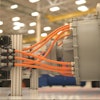MORGANTOWN, W.Va. (AP) — Mine operators must immediately begin phasing out use of an emergency breathing device that has proven unreliable in tests and must take the questionable model out of every U.S. mine by Dec. 31, 2013, the federal Mine Safety and Health Administration said Thursday.
MSHA estimates that about 66,000 of the potentially defective air packs called self-contained self-rescuers are currently in use. The model of concern is the SR-100, once manufactured by CSE Corp. of Monroeville, Pa. The company no longer makes or sells it.
Miners who are on the front lines — conducting safety inspections, pumping out water and doing other tasks that allow crews to start work — must get new gear within 30 days, MSHA chief Joe Main told The Associated Press in a phone interview. Operators can either replace the SR-100 or give those miners a second backup model to carry.
All other miners must have either new or backup equipment by April 26, 2013, Main said. That should remove about 38,000 SR-100s within a year.
Operators then have until year's end to remove the SR-100s that are in the emergency caches required under a federal law passed after the Sago Mine explosion killed 12 West Virginia coal miners in January 2006.
MSHA issued the order with the National Institute for Occupational Safety and Health, which said the SR-100 failed too many tests and is therefore critically flawed.
The belt-worn SR-100, about the size of two cake-mix boxes, contains chemicals that help recycle exhaled breath, scrubbing the carbon dioxide and generating about an hour's worth of breathable air. Hypothetically, that gives miners time to seek refuge or escape from a fire or explosion.
CSE voluntarily stopped production of that model when its own quality-control teams identified problems. President Scott Shearer told The Associated Press last week that it has since redesigned the oxygen-starter system and replaced the device with the SRLD model.
The new model holds more chemicals, he said, and provides more oxygen more quickly. Shearer said Thursday he's confident his company will be able to meet demand for the newer devices.
"CSE is now, and has always been, dedicated to miner safety," the company said later in a prepared statement, "and we want to ensure that every miner has the proper safety equipment."
Out of 500 old units that NIOSH randomly sampled starting in October 2010, five had oxygen starters that failed, according to its recently released report. Under federal rules, no more than three in 500 can fail for NIOSH to remain confident.
Because CSE couldn't determine the precise cause for the failure and confine it to specific production lots, NIOSH said it had to assume "the failure could exist among all field-deployed units."
Main said the phase-out strategy is aimed at providing maximum protection for miners while also giving operators time to purchase and deploy new devices.
If MSHA were to require immediate removal of all SR-100s, suppliers might not be able to meet industry's demand. The phase-out, Main said, givesmanufacturers time to ramp up production.
"Though we would like to see these units out of the mines even sooner," said United Mine Workers of America spokesman Phil Smith, "there really is no feasible way to replace all the SR-100s with other approved units much faster than MSHA is calling for."
They're simply not available yet, Smith said. But the union is pleased that MSHA agreed to order inspectors to brief miners on every shift directly, rather than post a note on a bulletin board.
And, Smith added, "there is nothing keeping mine operators from implementing this change ahead of the timeline MSHA has set as they acquire new units."
Main said MSHA held a conference call with industry leaders before the official announcement.
"Everyone that has been close to this understood there had to be some action," he said. "This should not have been a surprise to the mining industry."
In fact, industry officials have long known there were problems with the SR-100.
Sago survivor Randal McCloy told investigators that several SR-100s his crew was carrying failed after the blast that trapped 13 men. Only McCloy survived the 40-hour wait for rescuers in poisoned air.
In October 2006, the West Virginia Office of Miners' Health, Safety and Training issued a report on the air packs, concluding that exposure to extreme temperatures for long periods could render them inoperable when most needed.
That report said the most notable problem identified through testing was "failure of the compressed oxygen cylinder starter to provide sufficient gas to inflate the breathing bag."
Of 16 devices tested, only one fully inflated when the oxygen actuator tag was pulled, the report said. One partially inflated, while three did not visibly inflate but did show at least some oxygen increase.
The report looked only at the SR-100 but said other models are likely carried by their users in the same way, either stored underground for long periods or carried in vehicles and subjected to either extreme heat or cold.
Such handling, the report warned, "could result in degraded performance in any SCSR."






















